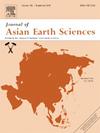A genetic link between magmatic evolution and indium mineralization in the Dulong Sn-polymetallic deposit, Southwest China: Constraints from the compositions of mica and apatite
IF 2.7
3区 地球科学
Q2 GEOSCIENCES, MULTIDISCIPLINARY
引用次数: 0
Abstract
The Dulong deposit is a world-class Sn-polymetallic deposit with indium mineralization, which is associated with highly evolved Late Cretaceous S-type granites, indicating the magmatism is crucial for the indium enrichment. Through integrated in-situ geochemical analyses of mica and apatite across variably fractionated granites and country rocks, this study reveals a systematic evolution of redox conditions, halogen chemistry, and metal enrichment during magmatic differentiation. As magmatic evolution progresses, indium and tin contentratons in mica increase progressively, reaching peak vales in the late stage of evolution at Dulong deposit. Notably, indium concentration in muscovite is greater than that in biotite, when muscovite converts into phengite. Apatite and mica compositions indicate low oxygen fugacity (fO2) magmatism. Fe-rich biotite in Sn-In-bearing granites contrasts with Mg-biotite in Sn-poor systems, with Fe3+/(Fe2++Fe3+) ratios < 0.2 confirming reduced fO2 conditions conducive to indium melt incorporation. Apatite geochemistry reinforces this: low SO3 (0.01–0.08 wt%), As depletion (14.54–42.10 ppm), and marked negative Eu anomalies (Eu/Eu* <0.4). Multi-proxy evidence collectively confirms a reduced magmatic system. Integrated proxies confirm a reduced magmatic system where progressive redox reduction during differentiation fosters indium enrichment, enhancing metallogenic potential. Concurrently, apatite halogen signatures track magmatic evolution: sustained F enrichment with late Cl spikes aligns with mantle-derived inputs evidenced by mafic enclaves. Although Cl concentrations remain low in the early magmatic stages, their subsequent dramatic increase correlates temporally and genetically with marked enrichment of In and Sn during later evolutionary phases. The mixing of mantle-derived magmas may bring in Cl-rich fluids/melts and related ore-forming materials, which promotes indium mineralization. The concurrent enrichment of halogen elements, F and Cl, plays a crucial role in the extraordinary accumulation of indium.
独龙锡多金属矿床岩浆演化与铟成矿的成因联系——来自云母和磷灰石组成的制约
独龙矿床是世界级的含铟锡多金属矿床,与晚白垩世高度演化的s型花岗岩伴生,岩浆活动对铟的富集起着至关重要的作用。通过对不同分选花岗岩和乡村岩石中云母和磷灰石的综合原位地球化学分析,揭示了岩浆分异过程中氧化还原条件、卤素化学和金属富集的系统演化。随着岩浆演化的进行,云母中铟、锡含量逐渐增加,在独龙矿床演化后期达到峰值。值得注意的是,当白云母转化为云母时,其铟浓度大于黑云母。磷灰石和云母组成表明岩浆活动具有低氧逸度(fO2)。富铁黑云母在含锡花岗岩中与贫锡体系中的镁黑云母对比,Fe3+/(Fe2++Fe3+)比值<;0.2确认有利于铟熔体掺入的fO2降低条件。磷灰石地球化学强化了这一点:低SO3 (0.01-0.08 wt%), As耗散(14.54-42.10 ppm),以及明显的负Eu异常(Eu/Eu* <0.4)。多代理证据共同证实了一个缩减的岩浆系统。综合代理证实了一个减少的岩浆系统,在分化过程中,逐渐的氧化还原还原促进了铟的富集,增强了成矿潜力。同时,磷灰石卤素特征跟踪岩浆演化:晚期Cl峰值的持续F富集与幔源输入一致,由基性包裹体证明。虽然Cl浓度在早期岩浆阶段保持较低水平,但其随后的急剧增加与后期演化阶段显著富集的in和Sn具有时间和遗传上的相关性。幔源岩浆的混合作用可能带来富cl流体/熔体及相关成矿物质,促进了铟的成矿作用。卤素元素F和Cl的同时富集在铟的异常富集中起着至关重要的作用。
本文章由计算机程序翻译,如有差异,请以英文原文为准。
求助全文
约1分钟内获得全文
求助全文
来源期刊

Journal of Asian Earth Sciences
地学-地球科学综合
CiteScore
5.90
自引率
10.00%
发文量
324
审稿时长
71 days
期刊介绍:
Journal of Asian Earth Sciences has an open access mirror journal Journal of Asian Earth Sciences: X, sharing the same aims and scope, editorial team, submission system and rigorous peer review.
The Journal of Asian Earth Sciences is an international interdisciplinary journal devoted to all aspects of research related to the solid Earth Sciences of Asia. The Journal publishes high quality, peer-reviewed scientific papers on the regional geology, tectonics, geochemistry and geophysics of Asia. It will be devoted primarily to research papers but short communications relating to new developments of broad interest, reviews and book reviews will also be included. Papers must have international appeal and should present work of more than local significance.
The scope includes deep processes of the Asian continent and its adjacent oceans; seismology and earthquakes; orogeny, magmatism, metamorphism and volcanism; growth, deformation and destruction of the Asian crust; crust-mantle interaction; evolution of life (early life, biostratigraphy, biogeography and mass-extinction); fluids, fluxes and reservoirs of mineral and energy resources; surface processes (weathering, erosion, transport and deposition of sediments) and resulting geomorphology; and the response of the Earth to global climate change as viewed within the Asian continent and surrounding oceans.
 求助内容:
求助内容: 应助结果提醒方式:
应助结果提醒方式:


